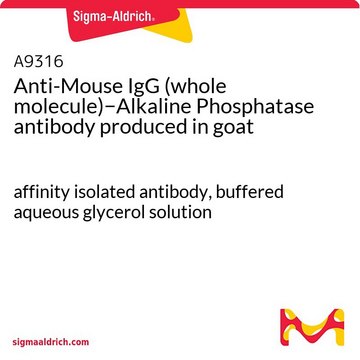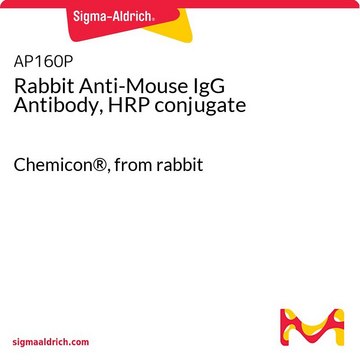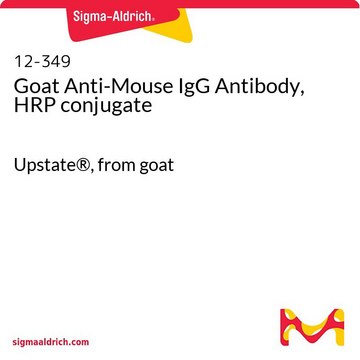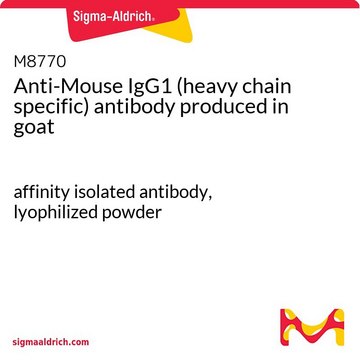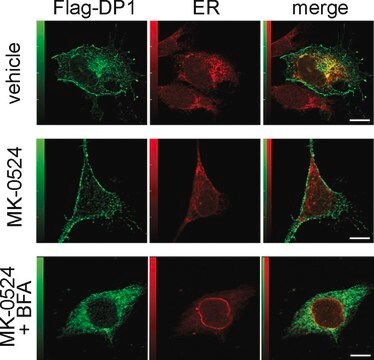おすすめの製品
由来生物
rabbit
品質水準
抗体製品の状態
affinity isolated antibody
抗体製品タイプ
primary antibodies
クローン
polyclonal
精製方法
affinity chromatography
交差性
rat, mouse, human
交差性(ホモロジーによる予測)
rhesus macaque (based on 100% sequence homology)
テクニック
immunohistochemistry: suitable (paraffin)
western blot: suitable
NCBIアクセッション番号
UniProtアクセッション番号
輸送温度
wet ice
ターゲットの翻訳後修飾
unmodified
遺伝子情報
human ... FGF10(2255)
詳細
Fibroblast growth factor 10 (FGF10) is a member of the fibroblast growth factor family and plays an essential role in the regulation of cell differentiation, tissue repair, tumor growth, embryonic development, and cell proliferation. Mutations in FGF10 have been associated lacrimo-auriculo-dento-digital syndrome (LADDS) which is a form of ectodermal dysplasia.
免疫原
KLH-conjugated linear peptide corresponding to human FGF10.
アプリケーション
Research Category
ニューロサイエンス
ニューロサイエンス
Research Sub Category
神経変性疾患
神経変性疾患
Detect FGF10 using this Anti-FGF10 Antibody validated for use in WB, IH(P).
Western Blot Analysis: 0.5 µg/mL from a representative lot detected FGF10 on 10 µg of mouse embryo tissue lysate.
Immunohistochemistry Analysis: A 1:1,000 dilution from a representative lot detected FGF10 in mouse epithelial cells, mouse liver, human brain, and human cerebellum tissues.
Immunohistochemistry Analysis: A 1:1,000 dilution from a representative lot detected FGF10 in mouse epithelial cells, mouse liver, human brain, and human cerebellum tissues.
品質
Evaluated by Western Blot in A549 cell lysate.
Western Blot Analysis: 0.5 µg/mL of this antibody detected FGF10 on 10 µg of A549 cell lysate.
Western Blot Analysis: 0.5 µg/mL of this antibody detected FGF10 on 10 µg of A549 cell lysate.
ターゲットの説明
~23 kDa observed
物理的形状
Affinity purified
Purified Rabbit Polyclonal in buffer containing 0.1 M Tris-Glycine (pH 7.4) and 150 mM NaCl with 0.05% sodium azide.
保管および安定性
Stable for 1 year at 2-8°C from date of receipt.
アナリシスノート
Control
A549 cell lysate
A549 cell lysate
その他情報
Concentration: Please refer to the Certificate of Analysis for the lot-specific concentration.
免責事項
Unless otherwise stated in our catalog or other company documentation accompanying the product(s), our products are intended for research use only and are not to be used for any other purpose, which includes but is not limited to, unauthorized commercial uses, in vitro diagnostic uses, ex vivo or in vivo therapeutic uses or any type of consumption or application to humans or animals.
適切な製品が見つかりませんか。
製品選択ツール.をお試しください
保管分類コード
12 - Non Combustible Liquids
WGK
WGK 1
引火点(°F)
Not applicable
引火点(℃)
Not applicable
適用法令
試験研究用途を考慮した関連法令を主に挙げております。化学物質以外については、一部の情報のみ提供しています。 製品を安全かつ合法的に使用することは、使用者の義務です。最新情報により修正される場合があります。WEBの反映には時間を要することがあるため、適宜SDSをご参照ください。
Jan Code
ABN44:
試験成績書(COA)
製品のロット番号・バッチ番号を入力して、試験成績書(COA) を検索できます。ロット番号・バッチ番号は、製品ラベルに「Lot」または「Batch」に続いて記載されています。
Shawn Liang et al.
Development (Cambridge, England), 145(2) (2018-01-24)
The developmental program that regulates thyroid progenitor cell proliferation is largely unknown. Here, we show that branching-like morphogenesis is a driving force to attain final size of the embryonic thyroid gland in mice. Sox9, a key factor in branching organ
Handeng Lyu et al.
Cell reports, 41(12), 111863-111863 (2022-12-22)
In injured airways of the adult lung, epithelial progenitors are called upon to repair by nearby mesenchymal cells via signals transmitted through the niche. Currently, it is unclear whether repair is coordinated by the mesenchymal cells that maintain the niche
Lemonia Chatzeli et al.
Journal of anatomy, 238(6), 1371-1385 (2021-01-18)
A common question in organ regeneration is the extent to which regeneration recapitulates embryonic development. To investigate this concept, we compared the expression of two highly interlinked and essential genes for salivary gland development, Sox9 and Fgf10, during submandibular gland
Gulsan Ara Sathi et al.
Journal of cell science, 130(9), 1559-1569 (2017-03-30)
The importance of macrophages in tissue development and regeneration has been strongly emphasized. However, the specific roles of macrophage colony-stimulating factor (MCSF), the key regulator of macrophage differentiation, in glandular tissue development have been unexplored. Here, we disclose new macrophage-independent
Carina Fischer et al.
Nature communications, 8(1), 2079-2079 (2017-12-14)
Understanding the molecular mechanisms regulating beige adipocyte formation may lead to the development of new therapies to combat obesity. Here, we report a miRNA-based autocrine regulatory pathway that controls differentiation of preadipocytes into beige adipocytes. We identify miR-327 as one
ライフサイエンス、有機合成、材料科学、クロマトグラフィー、分析など、あらゆる分野の研究に経験のあるメンバーがおります。.
製品に関するお問い合わせはこちら(テクニカルサービス)

